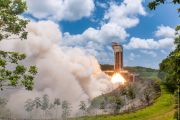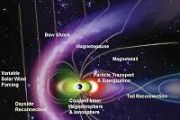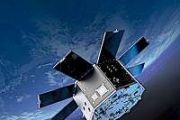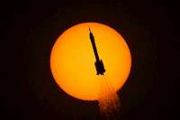
Copernical Team
A-74 iceberg near collision with Brunt Ice Shelf
 Image:
New radar images show the A-74 iceberg spinning around the western tip of the Brunt Ice Shelf, brushing slightly against it before continuing southwards.
Image:
New radar images show the A-74 iceberg spinning around the western tip of the Brunt Ice Shelf, brushing slightly against it before continuing southwards. Greenland, Antarctica will respond differently to increased future warming
 The recently released IPCC Sixth Assessment Report predicts faster warming of Earth's atmosphere and oceans compared to previous assessments. Now, new research shows how the new generation of climate models used in the assessment differ from earlier models in their prediction of the impact on the Antarctic and Greenland ice sheets on sea level rise.
The new study predicts that, by 2100, ad
The recently released IPCC Sixth Assessment Report predicts faster warming of Earth's atmosphere and oceans compared to previous assessments. Now, new research shows how the new generation of climate models used in the assessment differ from earlier models in their prediction of the impact on the Antarctic and Greenland ice sheets on sea level rise.
The new study predicts that, by 2100, ad FSU researchers refine estimate of amount of carbon in Earth's outer core
 New research from Florida State University and Rice University is providing a better estimate of the amount of carbon in the Earth's outer core, and the work suggests the core could be the planet's largest reservoir of that element.
The research, published in the journal Communications Earth and Environment, estimates that 0.3 to 2.0 percent of the Earth's outer core is carbon.
Thoug
New research from Florida State University and Rice University is providing a better estimate of the amount of carbon in the Earth's outer core, and the work suggests the core could be the planet's largest reservoir of that element.
The research, published in the journal Communications Earth and Environment, estimates that 0.3 to 2.0 percent of the Earth's outer core is carbon.
Thoug NASA watches water to help grow our groceries
 Every day - up to thirty times a day, in fact - one of Mark Mason's employees at Nature's Reward Farms in Monterey County, California brings him the results of a soil test for discussion.
Mason supervises fertilizer and irrigation for the farm's 5,000 acres along California's Central Coast, which is nicknamed "America's Salad Bowl" and is one of the most productive and diverse agricultural
Every day - up to thirty times a day, in fact - one of Mark Mason's employees at Nature's Reward Farms in Monterey County, California brings him the results of a soil test for discussion.
Mason supervises fertilizer and irrigation for the farm's 5,000 acres along California's Central Coast, which is nicknamed "America's Salad Bowl" and is one of the most productive and diverse agricultural New chip scale atomic clock best yet for extreme environments
 Advanced military platforms, ocean-bottom survey systems and remote sensing applications all require precise timing for mission success. Chip Scale Atomic Clocks (CSACs) ensure stable and accurate timing even when Global Navigation Satellite Systems (GNSS) time signals are unavailable. Helping industrial and military system designers to meet this requirement, Microchip Technology Inc. has announ
Advanced military platforms, ocean-bottom survey systems and remote sensing applications all require precise timing for mission success. Chip Scale Atomic Clocks (CSACs) ensure stable and accurate timing even when Global Navigation Satellite Systems (GNSS) time signals are unavailable. Helping industrial and military system designers to meet this requirement, Microchip Technology Inc. has announ Scientists detect never-before-seen radio waves from nearby stars and distant galaxies
 Scientists have measured thousands of nearby stars and far away galaxies that have never been identified before at radio wavelengths, while studying a galactic body that neighbours our own Milky Way galaxy - the Large Magellanic Cloud.
Led by Keele University PhD student Clara M. Pennock and Reader in Astrophysics, Dr Jacco van Loon, the international team of researchers used the Australia
Scientists have measured thousands of nearby stars and far away galaxies that have never been identified before at radio wavelengths, while studying a galactic body that neighbours our own Milky Way galaxy - the Large Magellanic Cloud.
Led by Keele University PhD student Clara M. Pennock and Reader in Astrophysics, Dr Jacco van Loon, the international team of researchers used the Australia Researchers from IRSOL and IAC solve twenty-year-old paradox in solar physics
 In 1998, the journal Nature published a seminal letter concluding that a mysterious signal, which had been recently discovered analysing the polarization of sunlight, implies that the solar chromosphere (a very important layer of the solar atmosphere) is practically unmagnetised, in sharp contradiction with common wisdom. This paradox motivated laboratory experiments and theoretical investigatio
In 1998, the journal Nature published a seminal letter concluding that a mysterious signal, which had been recently discovered analysing the polarization of sunlight, implies that the solar chromosphere (a very important layer of the solar atmosphere) is practically unmagnetised, in sharp contradiction with common wisdom. This paradox motivated laboratory experiments and theoretical investigatio Construction begins on NOIRLab Windows on the Universe Center
 What was once the largest solar observatory in the world is now undergoing a transformation to become a one-of-a-kind facility for sharing the wonders of astronomy with people around the globe. Construction work has started to recast the McMath-Pierce Solar Telescope facility at Kitt Peak National Observatory into the NOIRLab Windows on the Universe Center for Astronomy Outreach.
Dedicated
What was once the largest solar observatory in the world is now undergoing a transformation to become a one-of-a-kind facility for sharing the wonders of astronomy with people around the globe. Construction work has started to recast the McMath-Pierce Solar Telescope facility at Kitt Peak National Observatory into the NOIRLab Windows on the Universe Center for Astronomy Outreach.
Dedicated NASA spacewalk briefing to highlight new solar array installation
 Two astronauts will venture outside the International Space Station Tuesday, Aug. 24, for a spacewalk to install a support bracket in preparation for future installation of the orbiting laboratory's third new solar array.
NASA will discuss the upcoming spacewalk during a news conference at 2 p.m. EDT Monday, Aug. 23. Live coverage of the news conference and spacewalk will air on NASA Telev
Two astronauts will venture outside the International Space Station Tuesday, Aug. 24, for a spacewalk to install a support bracket in preparation for future installation of the orbiting laboratory's third new solar array.
NASA will discuss the upcoming spacewalk during a news conference at 2 p.m. EDT Monday, Aug. 23. Live coverage of the news conference and spacewalk will air on NASA Telev Vibration tests for Moon rocket help ensure safe travels on road to space
 Driving down a bumpy gravel road, even an off-road vehicle experiences bumps and vibrations, partly because of the car's natural frequency. An object's natural frequency is the frequency or rate that it vibrates naturally when struck. When forces like speed and the smoothness of the road are just right, the car will vibrate in tune with that same frequency.
Rockets flying through the atmos
Driving down a bumpy gravel road, even an off-road vehicle experiences bumps and vibrations, partly because of the car's natural frequency. An object's natural frequency is the frequency or rate that it vibrates naturally when struck. When forces like speed and the smoothness of the road are just right, the car will vibrate in tune with that same frequency.
Rockets flying through the atmos 

































